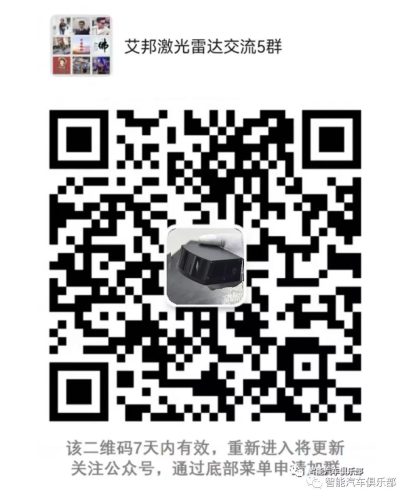-
What is lidar?
Lidar is an acronym for “light detection and ranging.” It is sometimes called “laser scanning” or “3D scanning.” The technology uses eye-safe laser beams to create a 3D representation of the surveyed environment. Lidar is used in many industries, including automotive, trucking, UAV/drones, industrial, mapping, and many more.
什么是激光雷达?
激光雷达是“光探测和测距“的缩写。它有时被称为“激光扫描“或“3D 扫描“。该技术使用对人眼安全的激光束来创建被调查环境的 3D 点云图。激光雷达用于许多行业,包括汽车、卡车运输、无人机、工业、地图测绘等等。
How does lidar work?
A typical lidar sensor emits pulsed light waves from a laser into the environment. These pulses bounce off surrounding objects and return to the sensor. The sensor uses the time it took for each pulse to return to the sensor to calculate the distance it traveled. Repeating this process millions of times per second creates a real-time 3D map of the environment. An onboard computer can utilize this 3D map of the surrounding environment for navigation.
激光雷达是如何工作的?
典型的激光雷达传感器从激光器向环境发射脉冲光波。这些脉冲从周围物体反弹并返回传感器。传感器使用每个脉冲返回传感器所需的时间来计算其行进的距离。每秒重复此过程数百万次,可以创建环境的实时3D 地图。车载计算机可以利用周围环境的 3D 地图进行导航。
Is lidar safe?
Yes, laser and lidar technology has been used safely for a long time in a wide variety of applications worldwide. Lasers are used today in the public in supermarkets, light shows, and home security systems. Manufacturers follow strict guidelines to ensure the sensors pass eye-safety standards.
激光雷达安全吗?
是的,激光和激光雷达技术已在全球范围内的各种应用中安全使用了很长时间。今天,公众在超市、灯光秀和家庭安全系统中使用激光。制造商遵循严格的指导方针,以确保传感器通过眼睛安全标准。
Is lidar eye safe?
Yes, Velodyne lidar sensors meet the FDA eye-safety standards under IEC 60825.
激光雷达眼睛安全吗?
是的,Velodyne 激光雷达传感器符合IEC 60825下的 FDA 眼睛安全标准。
Can a lidar sensor drive a car?
Lidar sensors do not drive a car. They provide the 3D vision for the car’s computer and mechanical system to make driving decisions.
激光雷达传感器可以驱动汽车吗?
激光雷达传感器不驱动汽车。它们为汽车的计算机和机械系统提供 3D 视觉以做出驾驶决策。
Why is lidar needed for autonomous vehicles?
Lidar sensors make autonomous vehicles possible by providing a high-resolution, real-time 3D view of the surroundings. Lidar provides autonomous vehicles 3D vision by generating and measuring billions of data points in real time, creating a precise map of the ever-changing surroundings for the vehicle to safely navigate. Lidar’s exceptional distance accuracy allows the vehicle’s system to identify and avoid objects. With lidar, the vehicle can “see” up to 300 meters on all sides with accuracy within a few centimeters. This enables the vehicle to drive itself at high speeds and navigate the road safely. Velodyne Lidar Inc. is the original inventor and market-leader in 3D lidar technology. Velodyne currently supplies more than 40 OEMs and new tech entrants worldwide. As a result, Velodyne’s sensors have been tested, validated, and utilized over millions of real-world road miles.
为什么自动驾驶汽车需要激光雷达?
激光雷达传感器通过提供周围环境的高分辨率、实时 3D 视图,使自动驾驶汽车成为可能。激光雷达通过实时生成和测量数十亿个数据点,为自动驾驶汽车提供 3D 视觉,为车辆创建不断变化的环境的精确地图,以便安全导航。激光雷达卓越的距离精度使车辆系统能够识别和避开物体。借助激光雷达,车辆可以“看到“多达 300 米的外所有物体,精度在几厘米以内。这使车辆能够高速行驶并安全地在道路上行驶。Velodyne Lidar Inc. 是 3D 激光雷达技术的原始发明者和市场领导者。Velodyne 目前为全球 40 多家OEM 和新技术进入者提供服务。最后,Velodyne 的传感器已经过数百万实际道路英里数的测试、验证和使用。
Does all lidar provide a 360-horizontal degree field of view?
No. Velodyne is unique in offering a multi-generational family of lidar sensors with 360-degree Field of View (FoV). There are certain applications, such as Advanced Driver Assistance Systems (ADAS), that do not require 360-degree FoV. In those cases, lidar with smaller horizontal FoV are available, such as Velodyne’s Velarray sensor, which has a horizontal FoV of 120 degrees.
是否所有激光雷达都提供 360 度水平的视野?
不会。 Velodyne 在提供具有 360 度视场 (FoV) 的多代激光雷达传感器系列方面是独一无二的。某些应用程序(例如高级驾驶辅助系统 (ADAS))不需要 360 度 FoV。在这些情况下,可以使用具有较小水平 FoV 的激光雷达,例如 Velodyne 的Velarray传感器,其水平 FoV 为 120 度。
What is solid state lidar?
Some people use the term “solid state” for lidar such as the Velarray, when in fact this technology is better described as having a Limited Field of View (LFoV). LFoV lidar are made with moving parts, such as moving mirrors. In contrast, 360-degree lidar are made of an internal solid-state mechanism that spins. The spinning mechanism is based on ball bearings, such as those used in robust jet engine systems. Frost and Sullivan describe Velodyne’s spinning lidar technology as solid-state hybrid (SSH) lidar.
There is no inherent difference in 3D vision quality between the 360-degree lidar and the LFoV lidar. However, the LFoV provides a slice of the environment. Its limited view typically spans from 90 degrees to 120 degrees. To “see” 360 degrees of the environment, LFoV pictures must be stitched together by the car’s computer. This requires extra processing and problems can arise in the “stitch lines.”
什么是固态激光雷达?
有些人将“固态“一词用于激光雷达,例如Velarray,而实际上这项技术被更好地描述为具有有限视场(LFoV)。LFoV 激光雷达由移动部件制成,例如移动反射镜。相比之下,360 度激光雷达是由内部固态机构制成的,可以旋转。旋转机构基于滚珠轴承,例如在坚固的喷气发动机系统中使用的滚珠轴承。Frost 和Sullivan 将 Velodyne 的旋转激光雷达技术描述为固态混合 (SSH) 激光雷达。
360度激光雷达和LFoV激光雷达在3D视觉质量上没有内在差异。但是,LFoV 提供了环境的一部分。其有限的视野范围通常从 90 度到 120 度。要“看到“360 度的环境,LFoV 图片必须由汽车电脑拼接在一起。这需要额外的处理,并且在“缝合线“中可能会出现问题。
Do lidar and other sensors have blind spots?
All sensors have defined field of views (FoVs) and resolutions. Blind spots or gaps in detection might occur based on the combination of sensors placed around the vehicle at specific locations. When multiple lidar sensors are mounted with care, placed to create overlapping FoVs around the vehicle, it is possible to minimize or eliminate crucial blind spots.
Sensors such as radar and cameras have blind spots. Cameras have nighttime blind spots with limited visibility in high glare or nighttime conditions. Radar has multiple blind spots because its technology is not refined enough to accurately identify objects.
激光雷达等传感器有盲点吗?
所有传感器都具有定义的视场 (FoV) 和分辨率。基于车辆周围特定位置的传感器组合,可能会出现检测盲点或间隙。当多个激光雷达传感器小心安装、放置以在车辆周围创建重叠 FoV 时,可以最大限度地减少或消除关键盲点。
雷达和摄像头等传感器存在盲点。摄像机有夜间盲点,在强光或夜间条件下能见度有限。雷达存在多个盲点,因为其技术不够完善,无法准确识别物体。
How many channels (laser beams) does a lidar sensor need for high resolution?
Depending on the application and the associated field of view, lidar with 8 to 128 laser beams (or lines) can be adequate. For example, a forklift can use a lidar with fewer sensor channels because it moves more slowly than a car. A car can be equipped with a 32 channel lidar to drive autonomously up to 35 MPH. To drive autonomously at 65 MPH, the driving system should be equipped with a lidar containing 128 channels. As a robot or vehicle moves faster, the sensor requires more channels to produce images in high resolution.
激光雷达传感器需要多少通道(激光束)才能获得高分辨率?
根据应用和相关的视场,具有 8 到 128 条激光束(或线)的激光雷达就足够了。例如,叉车可以使用传感器通道较少的激光雷达,因为它的移动速度比汽车慢。一辆汽车可以配备一个 32 通道的激光雷达,以高达 35 MPH 的速度自动驾驶。要以 65 MPH 的速度自动驾驶,驾驶系统应配备包含 128 个通道的激光雷达。随着机器人或车辆移动得更快,传感器需要更多的通道来产生高分辨率的图像。
How does lidar compare to camera systems?
Cameras produce 2D images of the environment and companies are installing them around vehicles to use for navigation. However, there are serious problems with the accuracy of proposed camera-centric systems that have not been solved and will likely not be solved soon.
Lidar “sees” in 3D, a huge advantage when accuracy and precision is paramount. The laser-based technology produces real-time, high-resolution 3D maps, or point clouds, of the surroundings, demonstrating a level of distance accuracy that is unmatched by cameras, even ones with stereo vision. Whereas cameras have to make assumptions about an object’s distance, lidar produces and provides exact measurements. For this reason, autonomous or highly-automated systems require lidar for safe navigation. The ability to “see” in 3D can’t be underestimated. Lidar produces billions of data points at nearly the speed of light. Each point provides a precise measurement of the environment. Compared to camera systems, lidar’s ability to “see” by way of precise mathematical measurements decreases the chance of feeding false information from the vision systems to the car’s computer.
Camera performance is also greatly impacted by environmental conditions (e.g., bright sunlight/glare and darkness) and is therefore more susceptible to unpredictable blind spots and generating false positives or negatives. Whereas cameras are dependent on ambient light conditions and face challenges with darkness and glare, lidar provides its own light source and can therefore “see” in all lighting conditions.
Lidar has an additional technological advantage over camera systems: lidar allows the vehicle’s computer to “see” the driving environment from an overhead, bird’s eye perspective. The car navigates not only from a traditional driver’s point of view, but can also “see” itself from the perspective of a bird flying overhead, similar to the views offered in many video games. Thus, lidar “sees” more comprehensively than a person, simultaneously looking down on all sides of the car, road, and traffic.
With accuracy and safety in mind, a lidar-centric autonomous system is a necessity. This means lidar is the central sensor and small inexpensive cameras can be added to the system for redundancy and extra care.
激光雷达与相机系统相比如何?
摄像头生成环境的 2D 图像,公司将它们安装在车辆周围以用于导航。然而,提出的以相机为中心的系统的准确性存在严重问题,尚未解决,并且可能不会很快解决。
激光雷达在 3D 中“看到“,当准确度和精度至高无上时,这是一个巨大的优势。基于激光的技术可生成周围环境的实时、高分辨率 3D 地图或点云,展示了相机无法比拟的距离精度水平,即使是具有立体视觉的相机。相机必须对物体的距离做出假设,而激光雷达则产生并提供精确的测量值。出于这个原因,自主或高度自动化的系统需要激光雷达来进行安全导航。在 3D 中“看“的能力不容小觑。激光雷达以接近光速的速度产生数十亿个数据点。每个点都提供对环境的精确测量。与相机系统相比,相机性能也受环境条件(例如,明亮的阳光/眩光和黑暗)的影响很大,因此更容易受到不可预测的盲点和产生误报或误报的影响。相机依赖于环境光线条件并面临黑暗和眩光的挑战,而激光雷达提供自己的光源,因此可以在所有照明条件下“看到“。
与摄像头系统相比,激光雷达还有一个额外的技术优势:激光雷达允许车辆的计算机从头顶的鸟瞰角度“看到“驾驶环境。汽车不仅可以从传统驾驶员的角度进行导航,还可以从头顶飞过的鸟的角度“看到“自己,类似于许多视频游戏中提供的视图。因此,激光雷达比人能更全面地“看到“,同时俯视汽车、道路和交通的各个方面。
考虑到准确性和安全性,以激光雷达为中心的自主系统是必要的。这意味着激光雷达是中央传感器,并且可以将小型廉价相机添加到系统中以实现冗余和额外护理。
What other sensors are needed along with lidar for autonomous driving?
Autonomous and highly-automated systems should be lidar centric, but other sensors, such as cameras and radar, can be helpful. Lidar should be the foundation of the system, providing the most comprehensive performance across a wide range of road conditions. Lidar can be supplemented by inexpensive cameras and radar for redundancy and extra care.
自动驾驶还需要哪些传感器和激光雷达?
自主和高度自动化的系统应该以激光雷达为中心,但其他传感器,如摄像头和其他雷达,可能会有所帮助。激光雷达应该是系统的基础,在各种路况下提供最全面的性能。激光雷达可以辅以廉价的摄像头和其他雷达,以实现冗余和额外的护理。
Why is higher resolution needed for autonomous vehicles?
Higher resolution lidar sensors generate billions more data points, providing the system with even more information upon which to base driving decisions. High-resolution lidar imaging is critical for enabling accurate object detection and classification, helping ensure that the vehicle drives safely and avoids collision. Resolution becomes even more important as the speed of the vehicle increases. To maximize safety as speed increases, which require the vehicle to detect and classify objects at a greater distance to maximize safety.
为什么自动驾驶汽车需要更高的分辨率?
更高分辨率的激光雷达传感器可生成数十亿个数据点,为系统提供更多信息,作为驾驶决策的基础。高分辨率激光雷达成像对于实现准确的物体检测和分类至关重要,有助于确保车辆安全行驶并避免碰撞。随着车辆速度的增加,分辨率变得更加重要。为了在速度增加时最大限度地提高安全性,这需要车辆在更远的距离内检测和分类物体,以最大限度地提高安全性。
How much resolution is needed for object identification?
Lidar resolution and object detection are enhanced by the very movement of a vehicle. In other words, the laser and data points that fall on an object multiply as a car moves down the road, filling in the details of the image. These allow the vehicle’s system to identify positions and gestures of pedestrians, traffic signs, even leaves on a tree. However, the required resolution for object detection increases as a vehicle speeds up. Since there is less time for the process, more lidar channels are needed. As the vehicle approaches highway speeds high resolution is important to accurately detect and classify objects, especially at a distance. A car moving at 65 mph might have only a few seconds to slow down and prevent a collision with an object in its path 200 meters away. Higher resolution enables the car to more accurately identify and classify the distant object early on and avoid collision.
物体识别需要多少分辨率?
车辆的运动增强了激光雷达分辨率和物体检测。换句话说,当汽车在路上行驶时,落在物体上的激光和数据点会成倍增加,从而填充图像的细节。这些使车辆系统能够识别行人、交通标志甚至树上树叶的位置和手势。然而,物体检测所需的分辨率随着车辆加速而增加。由于该过程的时间较少,因此需要更多的激光雷达通道。当车辆接近高速公路时,高分辨率对于准确检测和分类物体很重要,尤其是在远处。一辆以每小时 65 英里的速度行驶的汽车可能只有几秒钟的时间来减速并防止与 200 米外路径上的物体发生碰撞。
What is the difference between using a 1550 nm and a 905 nm wavelength laser in lidar?
Current lidar sensors typically use one of two wavelengths, either ~905 nanometers (nm) or ~1550 nm. We can better understand the differences between these wavelengths by comparing their performance with regards to safety, water absorption, and power consumption:
Safety
Sensors using 905 nm and 1550 nm wavelengths achieve eye-safety certification via compliance with the FDA eye-safety standard IEC 60825. If sensors are designed to meet eye-safety standards, both wavelengths can be used safely.
Water Absorption
Given the variety of weather conditions cars encounter on the road, how a sensor’s laser pulses interact with water is an essential issue for automotive lidar. A key difference between 905 nm and 1550 nm wavelengths is that 1550 nm waves get absorbed by water to a much greater extent than 905 nm waves, as discussed in a research paper published in Opto-Electronics Review. As a result, 1550 nm waves get substantially weakened under conditions of rain, fog or snow compared to 905 nm waves.
Power Consumption
To offset degradation due to water absorption and to achieve high range, 1550 nm systems generally send out more laser light to achieve performance comparable to 905 nm systems. As a result, 1550 nm systems typically consume more electrical power. Higher power could limit the maximum achievable operating temperature due to the challenge of dissipating the extra heat that is generated using higher power. A high-power requirement could also create the need for larger, more extensive equipment which must be stored in the vehicle. In general, the lower the lidar sensor’s power consumption, the more energy that an autonomous vehicle system can devote to other driving functions, such as object detection and avoidance.
在激光雷达中使用 1550 nm 和 905 nm 波长激光有什么区别?
当前的激光雷达传感器通常使用两种波长之一,即 ~905 纳米 (nm) 或 ~1550 nm。通过比较它们在安全性、吸水率和功耗方面的性能,我们可以更好地了解这些波长之间的差异:
使用 905 nm 和 1550 nm 波长的安全传感器通过符合 FDA 人眼安全标准 IEC 60825 来获得人眼安全认证。如果传感器的设计符合人眼安全标准,则两种波长都可以安全使用。
吸水
考虑到汽车在道路上遇到的各种天气条件,传感器的激光脉冲如何与水相互作用是汽车激光雷达的一个基本问题。正如发表在Opto-Electronics Review 上的一篇研究论文所讨论的那样,905 nm 和 1550 nm 波长之间的主要区别在于,1550 nm 波被水吸收的程度比 905 nm 波要大得多。因此,与 905 nm 波相比,1550 nm 波在雨、雾或雪条件下会显著减弱。
功耗
为了抵消因吸水而导致的退化并实现高范围,1550 nm 系统通常发出更多的激光,以实现与 905 nm 系统相当的性能。因此,1550 nm 系统通常会消耗更多电能。由于耗散使用更高功率产生的额外热量的挑战,更高的功率可能会限制可达到的最高工作温度。高功率要求还可能导致对必须存储在车辆中的更大、更广泛的设备的需求。一般来说,激光雷达传感器的功耗越低,自动驾驶汽车系统可以用于其他驾驶功能的能量就越多,例如物体检测和避让。

欢迎加入艾邦激光雷达产业通讯,目前有2700人,涵盖各大激光雷达厂商以及主机厂相关负责人,点击下方标签可以筛选
激光雷达 主机厂 自动驾驶 应用终端 激光器 VCSEL 光探测器 传感器 光学元件 光学模组 滤光片 振镜 光学部件 雷达罩盖 胶粘剂 电子元件 半导体 芯片 tier1 零部件 非标自动化 五金 线路板 电机 镀膜 镀膜设备 塑胶制品 汽车电子 表面处理 汽车配件 设备 检测设备 连接器 塑料 材料 软件 贸易 代理 高校 研究所 其他
资料下载:
